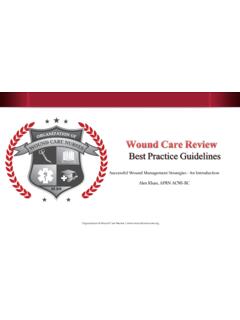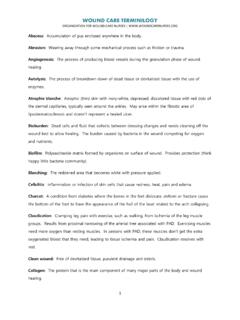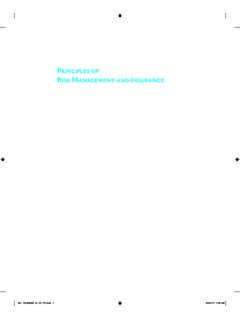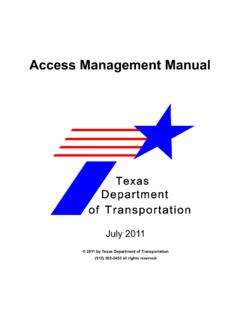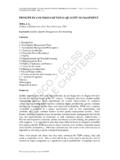Transcription of WOUND MANAGEMENT - Wound Care Nurses
1 WOUND MANAGEMENTA Clinical PerspectiveFurqan Alex Khan, APRN ACNS-BC Harris Davis, APRN FNP-C Understand types of wounds Discuss current evidence-based standard of care MANAGEMENT guidelines for different types of wounds. Discuss WOUND MANAGEMENT strategies for clients receiving Home Health Wounds have substantial adverse impact on client s quality of life and have a predictive risk with mortality. Better understanding of the etiology of the WOUND and following the evidenced based MANAGEMENT protocols can drastically improve client s health outcomes and lower the cost of the medical care . 2018 Preface PRESSURE ULCERS DIABETIC ULCER VENOUS STASIS ULCERS ARTERIAL ULCERSFUNGATING WOUNDSSURGICAL WOUNDS 2018 Types of Wounds A pressure ulcer is localized injury to the skin or underlying tissue usually over a bony prominence, because of unrelieved pressure and or in combination with shear and/or friction.
2 Pressure causes poor tissue perfusion and tissue damage can occur within 2-6 Ulcers Stage -I Non-blanchableerythemaIntact skin with non-blanchableredness of a localized area usually over a bony prominence. Darkly pigmented skin may not have visible blanching; its color may differ from the surrounding area. The area may be painful, firm, soft, warmer or cooler as compared to adjacent tissue. Category I may be difficult to detect in individuals with dark skin Ulcers Stage -I Non-blanchableerythema2018 Pressure Ulcers Stage-II Partial thicknessPartial thickness loss of dermis presenting as a shallow open ulcer with a red pink WOUND bed, without slough. May also present as an intact or open/ruptured serum-filled or sero-sanginousfilled blister. Presents as a shiny or dry shallow ulcer without slough or bruising*. This category should not be used to describe skin tears, tape burns, incontinence associated dermatitis, maceration or Ulcers Stage-II Partial thickness2018 Pressure Ulcers Stage-III Full thickness skin lossLossof epidermis & dermis with tissue loss extended to the subcutaneous fat.
3 Subcutaneous tissue may be visible but bone, tendon or muscle are not exposed. Slough may be present but does not obscure the depth of tissue loss. In contrast, areas of significant adiposity can develop extremely Ulcers Stage-III Full thickness skin loss2018 Pressure Ulcers Stage-IVFull thickness tissue lossFull thickness tissue loss with exposed bone, tendon or muscle. Partial slough or eschar may be present. Often includes undermining and tunneling. The depth of a Stage IV pressure ulcer varies by anatomical location. The bridge of the nose, ear, occiput and malleolus do not have (adipose) subcutaneous tissue and these ulcers can be shallow. 2018 Pressure Ulcers Stage-IVFull thickness tissue loss2018 Pressure Ulcers Un-Stageable-Full thickness tissue loss Depth UnknownFull thickness tissue loss in which actual depth of the ulcer is completely obscured by slough (yellow, tan, gray, green or brown) and/or eschar (tan, brown or black) in the WOUND bed.
4 Until enough slough and/or eschar are removed to expose the base of the WOUND , the true depth cannot be determined; but it will be either a Category/Stage III or Ulcers Un-Stageable-Full thickness tissue loss Depth Unknown2018 Pressure Ulcers Suspected Deep Tissue Injury Depth UnknownPurple or maroon localized area of discolored intact skin or blood-filled blister due to damage of underlying soft tissue from pressure and/or shear. The area may be preceded by tissue that is painful, firm, mushy, boggy, warmer or cooler as compared to adjacent tissue. The WOUND may further evolve and become covered by thin escharor may be rapid exposing additional layers of tissue even with optimal Ulcers Suspected Deep Tissue Injury Depth Unknown2018 Pressure Ulcers Friction & Shear MANAGEMENT *Use lift/turn sheets *Maintaining Head of Bead at <30 degrees Turn & Reposition frequently Pressure reduction & pressure redistribution utilizing low air loss mattress with alternating pressure Skin protection dressings over high risk areas.
5 *Pain MANAGEMENT Optimal Nutrition & Hydration MANAGEMENT Temperature : keeping skin cool, clean and dry Off-loading of pressure areas heel protectors Moisture barrier & skin protectant MANAGEMENT principles A diabetic or Neuropathic ulcer is defined as an injury causing loss of skin or tissue often on the feet due to lack of sensation (neuropathy). 2018 Diabetic/Neuropathic Ulcers 2018 Diabetic/Neuropathic Ulcers 2018 Diabetic/Neuropathic Ulcers Damage to blood vessels / Decreased circulation (PAD & PVD)Damage to nerves -NeuropathyDecreased immune responseDelayed response to tissue injuryDefective Matrix production & depositionDeformity2018 Diabetic/Neuropathic Ulcers Neuropathy associated with Diabetes Mellitus can be classified as:Sensory NeuropathyMotor NeuropathyAutonomic Neuropathy2018 Diabetic/Neuropathic Ulcers Sensory NeuropathyThe most common type of diabetic neuropathy, causes pain or loss of feeling in the toes, feet, legs, hands, and arms2018 Diabetic/Neuropathic Ulcers Motor NeuropathyLeads to paralysis of the foot's intrinsic muscles resulting in muscle atrophy that predispose patients with diabetes to plantar ulceration by increasing plantar pressures and shear Ulcers Autonomic NeuropathyIncreases the risk of neuropathic ulceration due to disturbances in sweating mechanisms, callus formation, and blood flow.
6 It also effects heart, blood vessels, digestive system, urinary tract, eyes, lungs & sex Ulcers Comprehensive Assessment ToolHealth History : Allergies, Smoking, Medications of Ulceration: Current & Previous treatmentsDiabetes MANAGEMENT : Hemoglobin A1cFoot & Shoe Exam: Deformity, Improper shoes , Circulation / Pedal Pulses, Skin color , Temperature, Neuropathy, CallousMobility Status: Ambulatory, Wheelchair, Walker : Pre-Albumin, Vitamin D, Vitamin C2018 Diabetic/Neuropathic Ulcers Comprehensive Assessment ToolLocation of WOUND : Plantar | Lateral or Medial aspectDuration of Ulceration: When ulcer was first discoveredGrading of Ulcer: Wagner grading scaleDrainage or Odor: Type of drainage and odor; if anyWound edges: Calloused | Pink & soft | RolledPresence of Pain: Assessing sensory loss2018 Diabetic/Neuropathic Ulcers Wagner Grading ScaleGrade 1: Superficial Diabetic UlcerGrade 2: Ulcer extension Involves ligament, tendon, joint capsule or fascia, No abscess or OsteomyelitisGrade 3: Deep ulcer with abscess or OsteomyelitisGrade 4: Gangrene to portion of forefootGrade 5: Extensive gangrene of foot2018 Diabetic/Neuropathic Ulcers MANAGEMENT Infection prevention.
7 WOUND to Rule Out Brachial Index & Toe A1c 7% or debridementsto minimize Stasis Ulcers Venous HypertensionUnderlying Pathologic Mechanism for ChronicVenous Insufficiency (CVI) and Ulceration pump failure2018 Venous Stasis Ulcers 2018 Venous Stasis Ulcers Clinical Signs & Symptoms Gaiter Distribution Edema | 1+ Hemosiderin Staining | Discoloration of skin Venous Dermatitis | Marked Redness Atrophieblanche | Sluggish capillary refill Varicose veins | Lack of hairs on the legs Atrophy of the skin | Lipodermatosclerosis2018 Venous Stasis Ulcers MANAGEMENT principles Diagnostic Testing: Segmental Pressures, Duplex Imaging Compression Therapy ** Diuresis Diet Modification: Sodium monitoring & lose weight Life style Modification: Daily weights & physical activities2018 Arterial / Ischemic Ulcers Arterial or ischemic ulcers, are caused by the poor blood circulation to the lower extremities; peripheral artery disease (PAD).
8 Inadequate supply of oxygenated blood leads to tissue ischemia and / Ischemic Ulcers 2018 Arterial / Ischemic Ulcers Clinical Findings: Ischemic rest pain, pain relief w/dependency, loss of hair, Atrophic, shiny skin, Muscle wasting of calf or thigh, Trophic nail changes, Poor tissue perfusion, color changes, Coldness of the foot, Gangrene of toes, Absence of palpable pulse, Paraesthesia(numbness) Pulselessness(absence of pulses below the occlusion) Paralysis (sudden weakness in the limb) Extremity cool to touch2018 Arterial / Ischemic Ulcers MANAGEMENT principles Pain MANAGEMENT Vascular Surgery Referral for possible Revascularization Hyperbaric Oxygen Therapy (HBOT) If patient is not appropriate for surgical interventionKeep the wounds clean, dry and free from infectionNo compression !!! No Elastic or stretchable gauze rolls2018 Malignant / FungatingWounds A Fungating or Malignant WOUND occur when malignant cells invade the skin, blood and lymph vessels, and penetrate the epidermis.
9 This results in a loss of vascularity and therefore nourishment to the skin, leading to tissue death and necrosis. The lesion might be the result of a primary cancer or a metastasis to the skin. The term Fungating is utilized to describe a proliferative process in this types of / FungatingWounds 2018 Malignant / FungatingWounds Clinical Findings: Malignant wounds are usually polymicrobic, containing both aerobic and anaerobic bacteria causing foul odor and purulent drainage from the tissue bacteria emit putrescineand cadaverine, which results in foul odors and some aerobic bacteria such as Proteus and Klebsiellacan also produce foul / FungatingWounds MANAGEMENT principles : Managing malignant wounds is frequently based on expert opinion and the experiences of the clinicians. The assessment of a malignant WOUND requires clinician to gain insight into the patient s perception of the WOUND and its consequent impact on his/her life.
10 Nursing care requires counseling skills and knowing how to provide care that is based on an awareness of and insight into the patients experience2018 Malignant / FungatingWounds MANAGEMENT principles : Treatment selections should include those that provide minimum side effects and maximum benefit to the client. Establish goal of care Healingvs Palliation WOUND bed preparation will vary based on the goal. If palliation is the goal, tissue debridement and MANAGEMENT of bacterial overload is required to minimize odor and decrease risk of / FungatingWounds MANAGEMENT principles : Negative pressure WOUND therapy (NPWT) for moderate to high exudatingwounds. Foul odor MANAGEMENT Charcoal based dressings to minimize odors. Lavender oil soaked gauze for odor control & inflammation. Metronidazole powder : Topical treatment to minimize odors Pain management2018 Surgical Wounds A surgical WOUND is defined as an incision or WOUND which is associated with a surgical procedure.
